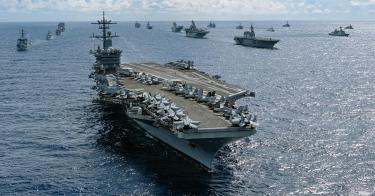Recently, the Navy quietly submitted a report required by the fiscal 2022 defense authorization bill. Thes classified report apparently details the number and type of warships needed to execute the national defense strategy. Little is known of this Battle Force Ship Assessment and Requirement report other than a goal of 373 ships.
This raises several questions. Why is this report classified? After all, long-range shipbuilding plans must be submitted periodically (the last came in April), and they are not classified. And why did Congress feel it necessary to stipulate that this latest report had to come directly from the Navy (versus the Secretary of Defense)?
There are three possible answers to the “why classified” question. First, there’s the military’s well-known tendency to over-classify everything. Unless this document offers insight regarding war planning, there is little reason for it to be classified. It would be highly unusual for the Navy to send Congress sensitive operational details.
That said, the law required the Navy to tell Congress about the fleet needed for routine operations and warfighting and its associated global force disposition. Some of this information might reasonably be classified.
A third possibility, of course, is that the report was classified for political reasons: to limit its distribution. A recent Politico article gives some insights to this and the internal machinations at the Pentagon at-play today regarding the Navy’s needed shipbuilding.
So we asked the Navy about it, and the response came back: “The BFSAR includes classified analysis and research.”
The bottom line is that, because the report is classified, the Navy will have a tougher time convincing a majority of lawmakers—and American public—of the need for a larger fleet.
This gets to the second question: Why is this being requested directly from the Navy? Again, there are several possible reasons. One, since the Chief of Naval Operations already submits a periodic long-range shipbuilding plan to Congress, this report could be viewed as just an outgrowth of that. Two, and perhaps more likely given the recent bipartisan frustration with Navy shipbuilding, the request was an attempt to reduce the Office of the Secretary of Defense’s ability to undercut the Navy’s requirements— the recent Politico article comes to mind.
But even if the full report had been made public, questions would still remain. Foremost among them: With the Navy’s capacity to rapidly bring on new warships crippled by a lack of key personnel, how can it possibly attain its goal of a 373-ship fleet?
Next month marks the one-year anniversary Navy Secretary Carlos Del Toro’s swearing-in, yet he still doesn’t have his team in place. Meanwhile, the Navy approaches several major institutional, procurement and warship design decisions that will have long-lasting impact.
Some political office holders working for Del Toro have been named, such as Erik K. Raven to be the Under Secretary of the Navy. Another early fill was Meredith Berger, confirmed in July 2021 as Assistant Secretary of the Navy for Energy, Installations, and Environment. But Berger was nominated before Del Toro, and Raven worked at the Senate while President Biden served there. Their appointments seem to have more to do with political relationships and green energy than military need.
Still missing in action in the Navy are the Assistant Secretaries for Manpower and Reserve Affairs, Financial Management and Comptroller and, critically, Research, Development & Acquisition. At a time that Congress is increasingly dissatisfied with naval shipbuilding plans, their principal point of contact—the top Navy acquisition chief—remains “a player to be named later.”
Remember the concern about the slow pace of filling key Pentagon positions in the Trump administration? “Trump Is Endangering U.S. National Security With Vacant Positions,” screamed Newsweek 16 months after Trump’s inauguration, and it was just one of many. Here we are 18 months after Biden’s inauguration, the picture for the Navy is much worse.
The absence of a permanent acquisition leader (the post is currently filled by its second temporary appointee) weakens the Navy’s political influence across the Defense Department and diminishes its ability to talk with Congress about shipbuilding and weapons procurement. This is particularly problematic now, when the Navy must soon decide on the next attack submarine, the next destroyer (to replace the Ticonderoga-class cruisers and succeed the Arleigh Burke-class destroyers), and what unmanned platforms will move into production.
And all the while, the danger of a conflict with China looms ever closer.
It is heartening that Congress has sought greater clarity from the Navy about its fleet needs for both peacetime competition and warfighting. It would be better if this report and the rationale for 373 ships could be shared openly. And better still to have a Navy acquisition chief in place to ensure those requirements are adequately resourced and met.
This piece originally appeared in Defense One




